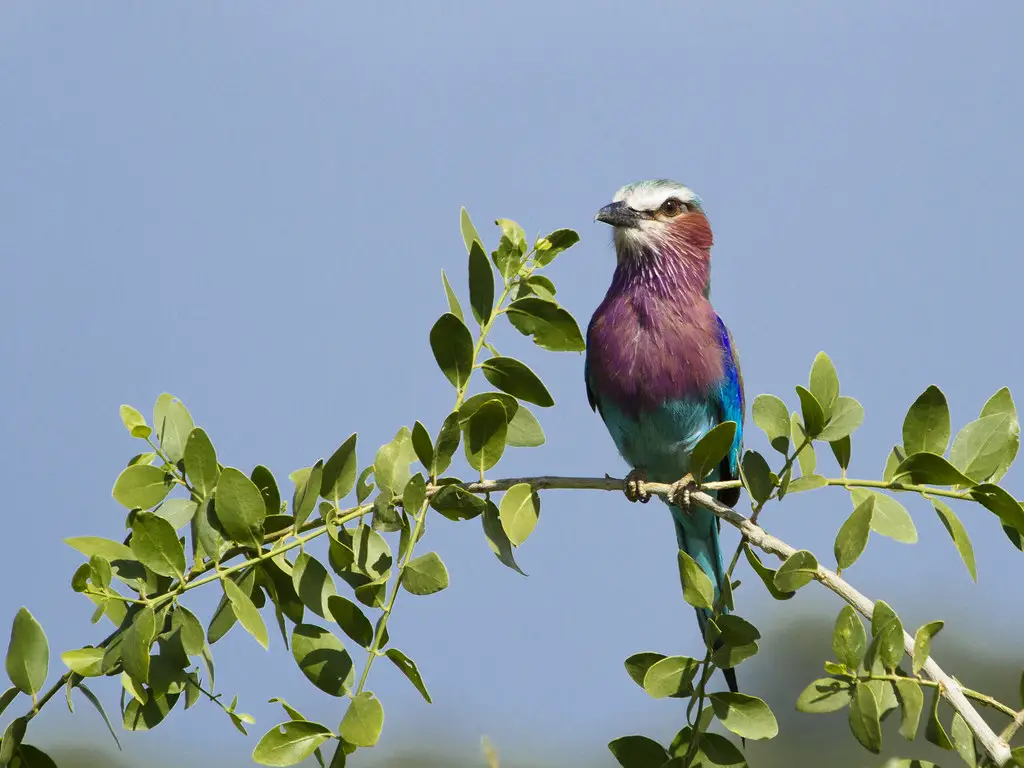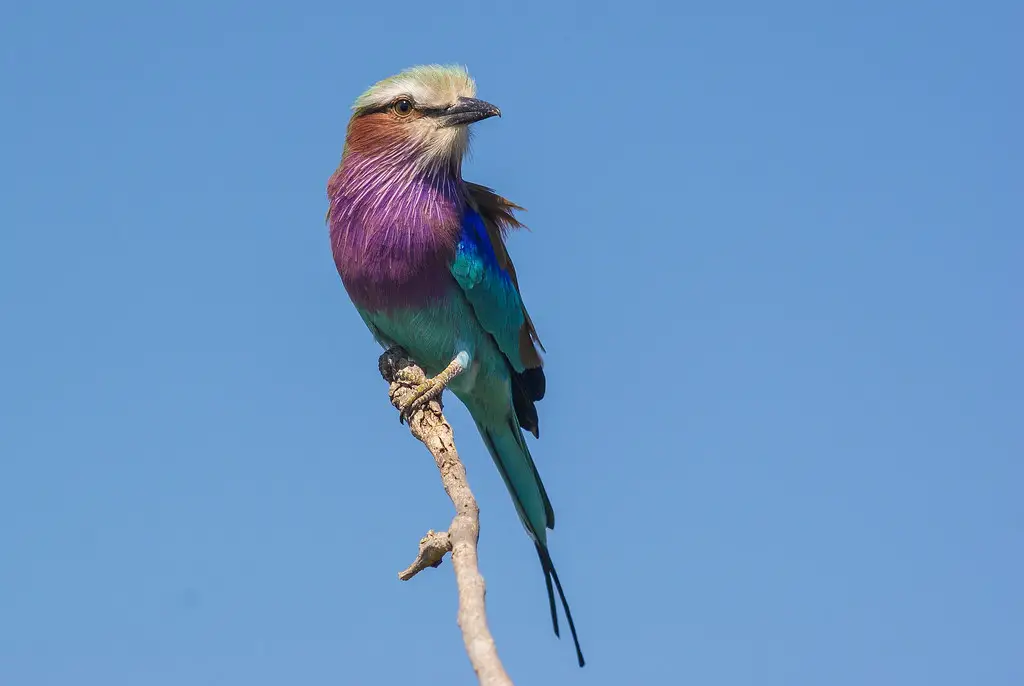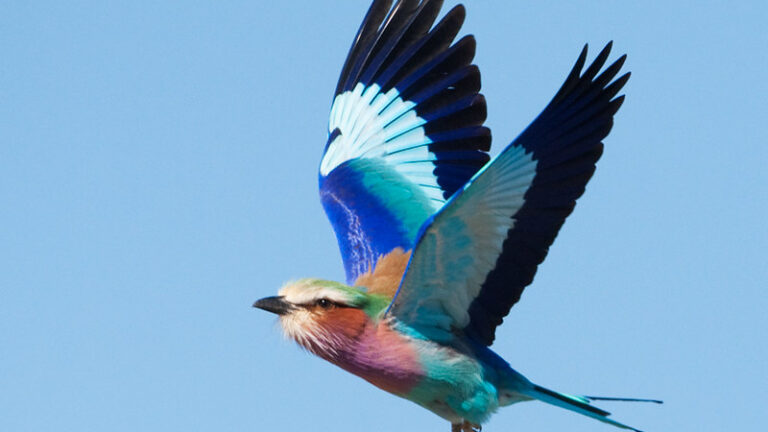Dive into the enchanting world of the lilac-breasted roller, a captivating member of the bird family known as Coraciidae. This swift and powerful flier boasts a vibrant array of colors and fascinating behaviors that make it a truly remarkable species. Let’s explore some intriguing facts about this beautiful bird.
All You Need To Know About Lilac Breasted Rollers
What’s the Scientific Name for the Lilac Breasted Roller?
Meet the lilac-breasted roller, scientifically known as Coracias caudatus. This fascinating bird was bestowed its distinctive name by the Swedish scientist Carl Linnaeus back in 1766. Beyond this general classification, there are two subspecies, namely C.c caudatus and C.c. lorti. The latter, often referred to as the “blue-breasted roller” or “lilac-throated roller,” inhabits different regions of Africa, and their territories do not intersect.

The Lilac Breasted Roller’s Striking Appearance
The lilac-breasted roller showcases a robust physique adorned with an array of captivating colors. Its prominent green head, accented by a sturdy black beak, exudes an air of strength. A distinctive white chin and a band of either white or yellow above the eyes and beak add elegance to its appearance. The breast, a rich shade of dark lilac, gradually lightens towards the throat.
The abdomen and the undersides of its wings are adorned with a turquoise hue, complemented by dark blue trim on the wings’ undersides. The upper wings display a warm reddish-brown tone. Adding to its allure, the lilac-breasted roller’s forked tail, also turquoise, gracefully concludes with black streamers.
Both males and females boast identical coloring. However, juvenile birds lack the striking black streamers, and their throats and breasts exhibit a reddish-brown hue. As they mature, these areas transform into the distinctive lilac shade.
Notably, the lilac-breasted roller features syndactyl feet, where the second and third toes are fused. Its upper legs flaunt turquoise feathers, while the lower legs and feet are bare, scaly, and tinted yellowish.
Lilac Breasted Roller’s Color Palette
Deserving of the name “rainbow roller,” this captivating bird dazzles with approximately eight colors. From the vivid green and white to the deep black, yellow, turquoise, dark blue, reddish-brown, and, of course, lilac, the lilac-breasted roller stands out as a truly multicolored marvel.

Mating Rituals of Rollers
The lilac-breasted roller, like its roller family counterparts, earned its common name from its intricate mating displays. These displays involve dynamic dives and swoops accompanied by loud and harsh cries. During the mating flight, the roller ascends about ten meters before gracefully swooping down with closed wings.
In another captivating aerial feat, the lilac-breasted roller engages in rolling maneuvers while flying at high speeds. Successful courtship in the air concludes with a mid-air mating ritual between the two birds.
Size and Weight
Measuring between 36 to 38 cm (14.2 to 15 in), the lilac-breasted roller encompasses its tail, which ranges from 8 to 9 cm (3.1 to 3.5 in) in length. With an average weight of 104 grams (3.7 ounces), males tend to be slightly larger than their female counterparts.
The Lilac-Breasted Roller’s Wing Span
This captivating bird unfurls its wings to reveal a wingspan spanning between 50 and 58 cm (19.7 and 22.8 in), showcasing its impressive aerial capabilities.
Friendliness and Territorial Nature
While the term “friendly” might be a stretch, lilac-breasted rollers exhibit a surprising lack of fear toward humans. Observers can approach these birds closely, providing a unique opportunity for photography.
Despite this apparent affability, lilac-breasted rollers are fiercely territorial. They vigorously defend their nests, showing objection to any perceived threats, even if eggs or chicks are not present. Additionally, these guardians of their hunting grounds are quick to chase away intruders.
How Long Do Lilac-Breasted Rollers Live?
In the wild, lilac-breasted rollers boast an average lifespan of approximately ten years, showcasing their resilience in their natural habitat. Impressively, when under the care of captivation, these vibrant birds can enjoy even longer lives. These rollers typically reach breeding maturity around the age of two.

Who are the predators of the Lilac-Breasted Roller?
The lilac-breasted roller, despite its striking appearance, faces threats from various birds of prey. Key predators in its natural environment include the Wahlberg’s eagle, the red-necked falcon, the peregrine, and the Bateleur. These predators play a crucial role in the natural balance of the lilac-breasted roller’s ecosystem.
Is the Lilac-Breasted Roller in Danger?
While researchers haven’t conducted a detailed assessment of the bird’s wild population, current indications suggest stability rather than decline. As of now, the lilac-breasted roller is not classified as an endangered species. This positive status highlights the importance of ongoing conservation efforts to maintain the well-being of these enchanting birds.
What Do Lilac-Breasted Rollers Eat?
Lilac-breasted rollers predominantly feast on insects, including beetles and grasshoppers. Their menu extends to include snails, scorpions, and occasionally, small lizards, rodents, and fellow birds. A fascinating aspect of their hunting strategy is their preference for high vantage points, such as treetops or telephone poles, where they patiently observe their surroundings.
The hunting process involves a dramatic swoop, as the lilac-breasted roller descends upon its prey, utilizing its wings to batter and subdue the target. Once victorious, they swallow the captured prey whole.
Clever Tactics During Brush Fires
Surprisingly, lilac-breasted rollers showcase intelligence and boldness by capitalizing on brush fires. As flames force small animals and insects to flee, these resourceful birds seize the opportunity, swooping down to capture prey in the midst of the chaos. In a remarkable display of adaptability, lilac-breasted rollers are known to hunt near the edges of fires, revealing a side of these beautiful birds that may surprise many.
Indeed, it’s a marvel that a bird so captivating shares certain survival strategies with the marabou stork, showcasing the diverse and intriguing world of avian behaviors.

Are Lilac-Breasted Rollers Monogumas
The lilac-breasted roller is thought to embrace monogamy, often forming lifelong bonds with their chosen mates. In the wild, these captivating birds are frequently observed solo or in pairs. During winter, small family groups may come together, showcasing a social dimension to their lives.
Lilac-Breasted Roller Reproduction
When it comes to expanding the family, lilac-breasted rollers typically lay two to four plain white eggs. Both parents actively share the responsibility of nurturing the eggs, with the hatchlings emerging after a span of 22 to 24 days. The newborns, categorized as altricial, depend on parental care, and it takes around 19 days for their feathers to fully develop. Remaining under the watchful eyes of their parents for an additional month, lilac-breasted rollers partake in the joy of parenthood just once a year.
The Lilac-Breasted Roller’s Vocal Symphony
The lilac-breasted roller communicates with a distinctive squawking sound, often likened to “zaak” or “raak.” These vocal expressions are particularly prominent during their mating flights, and at times, they may engage in perched calls while resting on branches. This auditory dimension adds to the allure of these remarkable birds, showcasing the various ways they interact with their environment and one another.
The Vocal Charms of Lilac-Breasted Rollers
Lilac-breasted rollers are not only a visual spectacle but also contribute to the auditory symphony of nature. These birds are known for their loud and harsh calls, with some likening the noise to the distinctive sound of a steam train.
Where are Lilac-Breasted Rollers Found
The lilac-breasted roller is primarily found in sub-Saharan Africa, extending its residence to the southern part of the Arabian Peninsula. Common sightings occur in Kenya, Zimbabwe, Botswana, northeastern South Africa, and significant portions of Namibia, excluding the Namib Desert. This vibrant bird is adaptable to various altitudes, ranging from sea level to just over 2000 meters (6562 feet), and it tends to stay within its local habitat without engaging in migratory behavior.
Lilac-Breasted Rollers’ Preferred Habitat
The lilac-breasted roller seeks refuge in savannas and open woodlands, where the presence of trees offers ideal perching and nesting spots. Remarkably, while unafraid of humans, these birds steer clear of human-altered environments like cities and farms.
Lilac-Breasted Rollers’ Nesting Practices
Nesting for lilac-breasted rollers is an artful affair. They favor trees, specifically seeking out natural holes within the trunk to safeguard their eggs. In a resourceful twist, they may repurpose abandoned kingfisher or woodpecker nest holes, or even choose termite mounds as their nesting grounds. Both parents valiantly defend the nest against potential threats, showcasing a commitment to safeguarding their future offspring.
Where to see the Lilac-Breasted Rollers
Lilac-breasted rollers can be admired in various settings. Zoos provide a convenient opportunity for observation, while Africa’s national parks, especially in Kenya, offer a chance to witness these birds in their natural habitat. In sparsely populated areas, strategic placement of tall trees or poles can entice lilac-breasted rollers to visit. Remarkably, these birds are known to adapt and use nesting boxes when other suitable options are scarce.
Lilac-Breasted Roller as the National Bird
The rooster and lilac-breasted roller jointly hold the esteemed title of the national bird of Kenya. This colorful bird, with its diverse hues, is a fitting representation of Kenya’s rich cultural diversity, home to over 40 ethnic groups.
Lilac-Breasted Roller’s Symbolic Presence
While Botswana lacks an officially declared national bird, the lilac-breasted roller is widely regarded as an unofficial emblem. Its prevalence, fearlessness in the presence of humans, and stunning plumage make it an ideal choice, particularly appreciated by bird enthusiasts.
Lilac-Breasted Rollers in African Folklore
The lilac-breasted roller has etched itself into the folklore of various African cultures. Historically seen as a symbol of peace, some tribes would ceremoniously sacrifice the bird to mark the end of wars. Intriguing marriage rituals also surround this vibrant creature, such as the Zulus’ use of feathered chains to assess a couple’s compatibility and the Venda’s crafting of wedding rings from lilac-breasted roller feathers. The Afrikaners, inspired by the belief in the bird’s lifelong mating, adorned wedding dresses with its feathers, weaving tales of tradition and symbolism.





